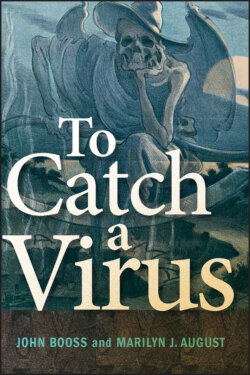Читать книгу To Catch a Virus - John Booss - Страница 15
Birth of Virology, “Filterable Viruses”
ОглавлениеNotably absent from the list of infectious diseases were the scourges that we now know as viral diseases. Diseases with telltale skin lesions such as disfiguring smallpox, measles, and the dramatic yellowing of malignant bilious fever or yellow fever did not succumb to isolation attempts on artificial media, nor did rage (rabies), long known for its transmission through the bite of a rabid dog. Fear of these diseases sparked scientists of the day to investigate their etiology and control. Edward Jenner’s revolutionary inoculation of vesicular material from cowpox lesions blunted or prevented dreaded smallpox in recipients. Likewise, Pasteur developed attenuated rabies virus material that he used to inoculate young Joseph Meister, bitten by a vicious, rabid dog. Meister’s miraculous survival unleashed a popular demand for vaccination against this frightful disease (12).
Epidemiological studies also fostered an understanding of viral disease even before viruses were actually defined and understood in the laboratory. Such was the case when Peter Ludwig Panum followed the transmission of measles to the Faroe Islands, a group of islands in the North Atlantic Ocean. The consequences of a ship’s carpenter incubating measles and delivering it to the remote Faroe Islands allowed Panum to define the transmission of this viral disease decades before the isolation and demonstration of the virus (27). In like manner, the mode of transmission of yellow fever was demonstrated before its characterization as a virus (29). That characterization depended on the defining tool of the virology laboratory; oddly enough, it was a filter customarily used to exclude bacteria. So important was that instrument that viruses were long known as “filterable viruses.”
Like Pasteur’s studies of silkworm diseases, the first recognition of viral diseases resulted from commercial urgency: a threat to the tobacco crop by mosaic disease. In 1885, Adolf Mayer demonstrated that infection could be transmitted by sap from diseased to healthy plants (24). In 1892, Ivanowski reported to the Academy of Science of St. Petersburg on the mosaic disease of the tobacco plant, “According to my experiments the filtered extract introduced into healthy plants produces the symptoms of the disease just as surely as does the unfiltered sap” (20). Independently, Martinus Beijerinck reported in 1898 that the tobacco disease could be transmitted through a porcelain candle filter and that tests for bacteria were negative (Fig. 4). He characterized the infection as a “contagium vivum fluidum,” or contagious living liquid, and suggested that one form could be “. . . a contagium that exists only in living tissues . . .” (3). Hence, two laboratory requirements defined viruses: passage through a porcelain filter and the need for living cells on which to grow.
Figure 4 Martinus Beijerinck in his laboratory, May 1921. Beijerinck, like Ivanowski, demonstrated that tobacco mosaic disease could be transmitted by sap which had passed through bacteriological filters. He also demonstrated the need for living cells to replicate the disease-causing factor, which he called contagium vivum fluidum. (Photo source: Wikimedia Commons, in the public domain.)
doi:10.1128/9781555818586.ch1.f4
For the first demonstration of a filterable agent in mammals, again the drive was commercial. Foot-and-mouth disease impaired cattle breeding and reduced milk production, bringing severe economic hardship to Prussian agriculture (35). Friedrich Loeffler, a collaborator of Koch and the discoverer of the diphtheria bacterium and toxin, was appointed in 1897 by the Prussian Ministry of Cultural Affairs to study foot-and-mouth disease. While readily transmissible experimentally, the agent was not visible microscopically. In collaboration with Paul Frosch, Loeffler demonstrated that foot-and-mouth disease could be transmitted to cows by bacterium-free lymph which had been passed through a Berkefeld filter (23). Experiments designed to detect the presence of a toxin resulted in retention of disease-producing activity, even at extremely high dilutions. This observation raised the possibility that the effect was produced by a germ which could multiply. The hope was that a vaccine could be developed. Unfortunately, as discussed by H.-P. Schmiedebach, a vaccine with persistent immunity-inducing capacity did not result, and foot-and-mouth disease remains a scourge to this day (35).
The work of Loeffler and Frosch stimulated work on yellow fever, a terrifying human viral disease which had been the subject of intense debate in the 19th century between the contagionists and the anticontagionists (1). Yellow fever was at once a political and commercial battle as well as a scientific matter. The politically liberal anticontagionists were against quarantines and the bureaucratic apparatus that supported quarantines. The French Academy of Medicine weighed in on the issue in 1828 against yellow fever quarantines. Thus, the matter of disease transmission had political overtones as well as commercial consequences. Walter Reed, as director of the U.S. Army Yellow Fever Commission, would definitively demonstrate the mode of yellow fever transmission. William Welch, the dean of American pathology, pointed out to Reed the possible relevance of the work of Loeffler and Frosch on foot-and-mouth disease to the etiology of yellow fever (30).
